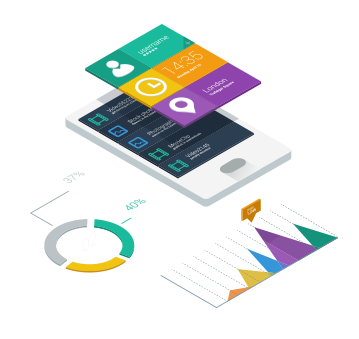
Weekly inspiration for the staffing industry.
THE TRUTH ABOUT MOBILE IN STAFFING
Mobile websites. Apps. Mobile job search. There's been a lot of hype about the growth of mobile in the staffing industry.
Looking at the data, the hype is pretty well founded:
- There are now more mobile devices than people on the planet.
- 68% of job seekers use mobile in their job search.
- Indeed and CareerBuilder estimate that 1/3 of their traffic is mobile.
- 62% of emails are now opened on a mobile device.
- Google is demoting websites that are not mobile optimized.
- Mobile optimization increases engagement 85%!
Mobile usage varies greatly by age and income (this has big implications for the future of recruiting):
Smartphone ownership by income/age grouping
% within each age/income grouping who own a smartphone (example: 77% of 18-29 year olds with an annual household income of less than $30,000 are smartphone owners)

Source: Pew Research Center's Internet & American Life Project, April 17-May 19, 2013 Tracking Survey. Interviews were conducted in English and Spanish and on landline and cell phones. Margin of error is +/- 2.3 percentage points based on all adults (n=2,252).
http://www.pewinternet.org/2013/06/05/smartphone-ownership-2013/
So what do all these numbers mean for your staffing firm?
They mean that mobile has become essential to your business.

-
Mobile is critical to your recruiting efforts.
If you're not optimizing mobile in recruiting, you will lose candidates. -
Mobile plays a big role in SEO.
If your website isn't mobile optimized, you'll drop in the rankings. -
Mobile changes how you approach sales.
It changes how, when and where you communicate with staffing decision makers. -
Mobile requires you to rethink your application process.
What works for a traditional candidate does NOT work for a mobile job seeker.
If your staffing firm doesn't have a mobile strategy, get one now! You are falling behind the competition!
Mobile Facts...and Fiction.
Fact: You need a mobile optimized website.
Fiction: You need a mobile app.
A mobile optimized website makes your site usable on tablets and smartphones. And thanks to recent changes by Google, it's also essential for SEO. There are several ways you can optimize your site for mobile users (see Options for Your Mobile site), but don't buy into the hype that you need a custom app developed.
For most staffing firms, apps are not necessary. Thanks to advances in web development, most of the information you want to present to employers and job seekers can be done without the high cost of custom app development (See There's an App for That).
Fact: A mobile optimized website is different than a desktop site.
Fiction: A responsive website is the best way to be mobile optimized.
People use mobile devices and desktop computers very differently.
- Mobile Users
- Used more frequently and for shorter visits.
- Used twice as often for social sharing.
- In staffing, mobile devices are used to search jobs, find directions, get phone numbers, exchange email, and complete activities like time tracking.
- Desktop Users
- Used heavily during business hours.
- Used to research detailed information.
- In staffing, desktops are used by people taking an in-depth look at your firm, searching jobs, accessing online portals, and completing an online application or testing
In website design today, there's a lot of talk about responsive site design. Simply put, responsive design is about coding your website so that the interface responds to the device being used to display the content. It's a "one site fits all" model.
While responsive design may be the hot trend, it's not always the right option. And responsive design can add a lot of cost to your website. Sometimes, it is faster, easier and more efficient to have a separate mobile site or use a mobile plug-in.
So what's the right solution? It depends on how your existing site is programmed, whether or not you plan to redevelop your corporate website, and the specific features and functions you want to offer on each platform. For more help deciding what you need to do, see Options for Going Mobile.
Fact: You need a mobile optimized application process.
Fiction: Your ATS will take care of it for you.
40 percent of mobile candidates abandon non-mobile job applications. And 74 percent of users will only wait five seconds for a web page to load on their mobile device. If you don't offer a fast, easy application process for smartphone users, you will lose candidates.
But don't expect the online application you use with your ATS to be the best solution for mobile. While the staffing software vendors are making great strides in optimizing their systems for mobile use, as of the time of this writing, almost all of the online applications are not mobile friendly.
 For a mobile application, the candidate needs to be able to:
For a mobile application, the candidate needs to be able to:
- Search jobs from their smartphones.
- Apply without having to attach a resume or complete a lengthy form.
- Save or forward job information to their email account for later review.
- And ideally, allow candidates to use a one-click apply option such as Apply with LinkedIn.
But if these features are not available from your ATS, you may need to use a third party product that offers these features (insert Haley Marketing sales pitch here!) and/or re-engineer your application process to have a different approach for mobile applicants.
Fact: 62% of email is read on a mobile device.
Fiction: Staffing sales reps know how to effectively leverage mobile email.
Many sales trainers will tell you that the best way to get past a gatekeeper is to call when the gatekeeper is not around (before 9 a.m. and after 5 p.m.). And when it comes to connecting with prospects and clients via email, this approach is even more effective.
Nearly two-thirds of all emails are being read on a mobile device. And it's common for executives to check email first thing in the morning and again before going to bed (not to mention while standing in lines, commuting, and doing just about everything else).
But is connecting with someone on a mobile device the same as on a desktop? No! On a mobile device, you need to design your emails to include:
- Shorter paragraphs
- Larger fonts
- Single column design (for graphic emails)
- Clear calls to action
- Bigger buttons (for graphic emails)
To maximize the impact of mobile email, your sales team needs training in regard to mobile email design and strategy. And if you have a newsletter, send out top candidates emails or do other email marketing, you need to consider responsive email design or mobile first email design.
There's an App for That
Mobile apps can be a great way to improve service to clients and candidates. And some staffing firms have developed powerful apps to create more exceptional customer experiences. Examples of these apps include:
While apps can be great for sales and service, they are not the right solution for every firm. Apps are very expensive to develop (costs range from several thousand to tens of thousands), and you need to create different version for each platform: iOS, Android and Blackberry. Once you develop the app, you then need to get it approved in the Apple Store and on Google Play, and finally, you need to get people to download and use the app--and that's no small challenge.
For most staffing firms, there are better--and cheaper--alternatives to app development. These include web applications (software that runs from the browser instead of a native app), responsive websites, and mobile themes.
Options For Going Mobile
1. Native Applications:These applications are specifically designed to run a certain device's operating system and typically need updates or adaptations to work properly for different devices. Native apps run the fastest, can offer the best interface, and are best for:
- Games
- Regular use and personalization.
- Complex calculations or reporting.
- Native functionality or processing required.
- Offline processing needed (when there's no Internet connection).
A Web app or HTML 5 app, is one in which all or some parts of the software are downloaded from the Web each time it is run. These apps typically run in the mobile device's Web browser. The type of device doesn't matter, as long as it is a Web-capable mobile or tablet. For tech geeks, Web apps don't depend on the specific operating system of the mobile device to run. And that means you don't need separate apps for every device.
Examples:
- YouTube
- Haley Marketing's job board software
Responsive website is one that adapts the content and layout to the device. There's only one version of the site, but it is programmed to adjust the layout to the size and shape of each screen.
4. Mobile Theme:This a less costly way to develop a website that responds to different devices. Like a responsive site, there is typically one version of the content, and you can use the them to control what displays (and what does not). Mobile themes are ideal for WordPress and other CMS based websites.
5. Separate Mobile Site:Generally speaking, this is the least desirable option. You literally create a second version of your website for mobile users. This means you end up with two websites to manage. However, it can be an ideal option when you have an old website that can't be easily updated...and you're not ready to build a new website.
What's best for YOU?
- Responsive
- New site
- You want device independence
- All content all places
- Sufficient budget
- Mobile Theme
- CMS-based site
- One version of content
- You want control over pages
- Low cost desired
- Separate Mobile
- Existing, non-mobile-friendly site
- You don't want to build a new site
- You want different content for mobile
- Low cost desired
Creating Your Mobile Strategy
1. Determine where you are now.Check Google Analytics on your website. How much mobile traffic do you have? What are the trends on your site? Determine what you need to offer (from a mobile perspective) based on how people are really using your website.
2. Set your goals.Are you trying to simplify your site for mobile, create an easy way to search jobs, or take your service process mobile? Once you know what you want to accomplish, you can determine the content and features you need to offer (both mobile and desktop).
3. Design your mobile strategy.Will your mobile site be client focused, candidate focused, or both? (Some staffing firms are opting for a "candidate only" career portal for their mobile websites.) Will you build a responsive site or use a mobile theme? Do you need to create an app? If so, native or web-based? And don't forget about content! Determine what you want to include--and exclude--on each platform.
4. Revamp your recruiting process (if needed).Consider how you might want your process to change to make it easier and more effective for mobile job seekers. Maybe you want a full application on your desktop and a quick apply for mobile. Or maybe you just want to request resumes as a first step on all devices and invite only the best candidates to complete your full application.
5. Train your sales team and recruiters (and improve their mobile marketing tools).Show your people the most effective ways to incorporate mobile in their sales and recruiting efforts--both in using mobile in their outbound efforts and connecting with mobile prospects and candidates. Don't forget to redesign your email communications for mobile response.
6. Get help.Implementing a mobile strategy takes a lot of technical, content and staffing expertise. Find the right partners to help you evaluate your options, and optimize your website, and more importantly, your recruiting and sales efforts for mobile. (And yes, Haley Marketing can plan a big role in helping you to define and implement your mobile strategy!)
More resources on mobile
- Haley Marketing Webinar on Mobile in Staffing
- Mobile Device Statistics
- Browser Statistics
- Smartphone Ownership Research





